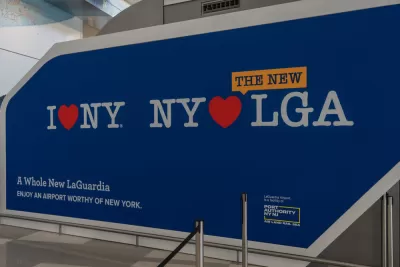After an $8 billion renovation, critics of the much-maligned airport claim the design is disjointed, while public transit access to the new terminals remains minimal.

In a piece for Bloomberg CityLab, James S. Russell describes the $8 billion renovation of “America’s most reviled airport,” New York’s LaGuardia.
Despite the massive investment in the modernization of the new terminals, the airport is, as Russell writes, “trapped in the husk of its reviled predecessor.” This is because “the ‘new’ LaGuardia’s expansion was constrained on a site that opened to pontooned flying boats and DC-3s in 1939. From the air, it looks like taffy pulled in several directions. Recently constructed buildings and roads had to dodge and weave among the detritus of boneheaded decisions past, including bits of the older terminals that had to remain in service as new ones were constructed.”
According to Russell, “Coherence and passenger-calming clarity in wayfinding have always been held sacrosanct by airport designers. But the new Terminal B — while a vast improvement that has been greeted with praise and was awarded the 2021 Prix Versailles, UNESCO’s annual architecture prize — is among the most idiosyncratic that air travelers are likely to encounter.” However, “Despite its busyness, the Terminal B pleases with its detailed focus on its users, from the new, roomier bathrooms to the unintimidating security checkpoint.” Russell goes on to describe Terminal C, designed by and for Delta to maximize efficiency and ease of experience for travelers.
The refreshed airport comes with another caveat: “Access to the airport is likely to continue to induce havoc, since there’s a lingering lack of roadway and parking capacity.” The airport continues to lack good access to public transit, and “ride-hailing services are accommodated as an afterthought.”
FULL STORY: The New LaGuardia Is Haunted by the Mistakes of its Past

Maui's Vacation Rental Debate Turns Ugly
Verbal attacks, misinformation campaigns and fistfights plague a high-stakes debate to convert thousands of vacation rentals into long-term housing.

Planetizen Federal Action Tracker
A weekly monitor of how Trump’s orders and actions are impacting planners and planning in America.

In Urban Planning, AI Prompting Could be the New Design Thinking
Creativity has long been key to great urban design. What if we see AI as our new creative partner?

King County Supportive Housing Program Offers Hope for Unhoused Residents
The county is taking a ‘Housing First’ approach that prioritizes getting people into housing, then offering wraparound supportive services.

Researchers Use AI to Get Clearer Picture of US Housing
Analysts are using artificial intelligence to supercharge their research by allowing them to comb through data faster. Though these AI tools can be error prone, they save time and housing researchers are optimistic about the future.

Making Shared Micromobility More Inclusive
Cities and shared mobility system operators can do more to include people with disabilities in planning and operations, per a new report.
Urban Design for Planners 1: Software Tools
This six-course series explores essential urban design concepts using open source software and equips planners with the tools they need to participate fully in the urban design process.
Planning for Universal Design
Learn the tools for implementing Universal Design in planning regulations.
planning NEXT
Appalachian Highlands Housing Partners
Mpact (founded as Rail~Volution)
City of Camden Redevelopment Agency
City of Astoria
City of Portland
City of Laramie



























